
Overall Rating

Plus & Minus
Plus Practicality; quality; offers something for the driver too
Minus Misses out on the punchier engines; questionable auto transmission logic; odd door mirror positioning
The Wheels Verdict: The CX-30 represents a formidable take on the ‘next-gen’ compact SUV by Mazda. Granted, the competition in this category isn’t the strongest, but the CX30 nevertheless makes a wholly convincing case.
WHAT IS THE MAZDA CX-30?
Think of this one as a CX-4, a vehicle that’s between the CX-3 and the CX-5 in size. Mazda can’t use that nameplate as it’s already fixed to the rump of a Chinese-market SUV, so had to come up with a Plan B. The CX-30 is the second ‘next-gen’ product on the Sky-active platform after the latest Mazda 3 and, even after a short drive, it’s clear that it’s a step on in terms of refinement and polish from what went before. In other words, it’s off to a good start.
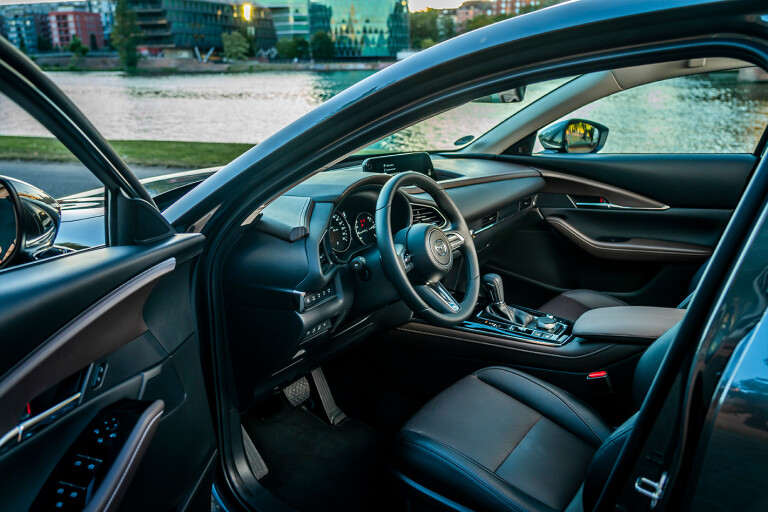
WHY WE’RE TESTING IT
We were invited to Germany to geek out over the latest SkyActiv-X engine, but Mazda also had early examples of the CX-30 available for us to have a quick pedal in. The drive route wasn’t ideal, but it was enough to get a taste of what Australian buyers can expect when it lands in dealers early next year.
MAZDA CX-30 REVIEW
Imagine you’re a car designer. Where do you start when coming up with a new model? Maybe with assessing what engineering platforms you have, what the hard points are for that chassis and then getting busy with some Play-Doh to sculpt a sexy silhouette. Or possibly by guest lecturing on a university car design course and plagiarising your students’ dissertation submissions. Ryo Yanagisawa and his team at Mazda, tasked with creating the CX-30 compact SUV, instead took a novel tack - they started by considering your pelvis.
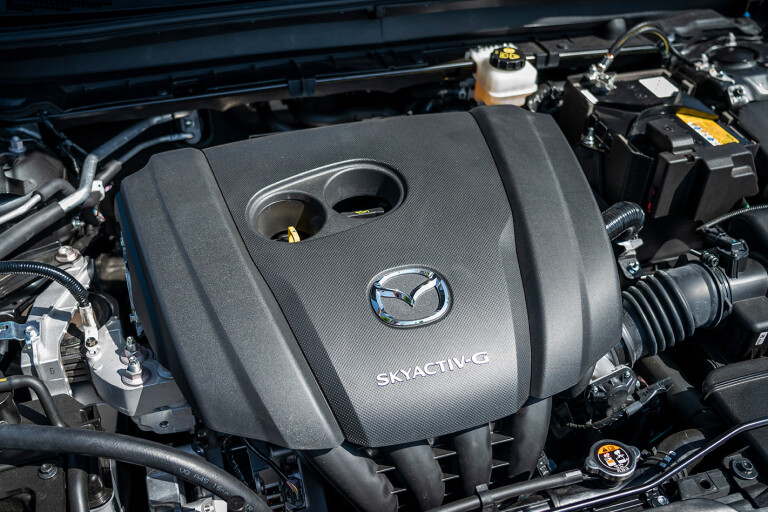
More specifically, they became fixated on the angle your pelvis adopts when it’s sitting in a car seat. Get that right, they argue, and a whole cascade of benefits falls into your lap, so to speak. Your spine has quite amazing shock absorption benefits, provides a natural balance to your core and keeps your head steady in the process. In order to do that, it needs to be in much the same alignment it is when you’re standing and to do that the pelvis needs to be upright. In most cars, the pelvis is angled backwards, your spine is therefore slumped, and you lose the feeling of balance and control. Mazda is very keen on balance and control.
That’s apparent in the first few hundred metres of driving the CX-30. About the biggest compliment you can give it is that the cabin doesn’t feel too different to a hatch like a Mazda 3, despite the centre of gravity being 45mm higher. The old CX-3 pulled off that trick, but then it was based on the tiny Mazda 2 underpinnings. More pertinently the CX-5 doesn’t. There’s a heft and delay to its responses that makes it feel its size. This gives rise to a gradual impression that Mazda has managed to ‘right-size’ the CX-30.
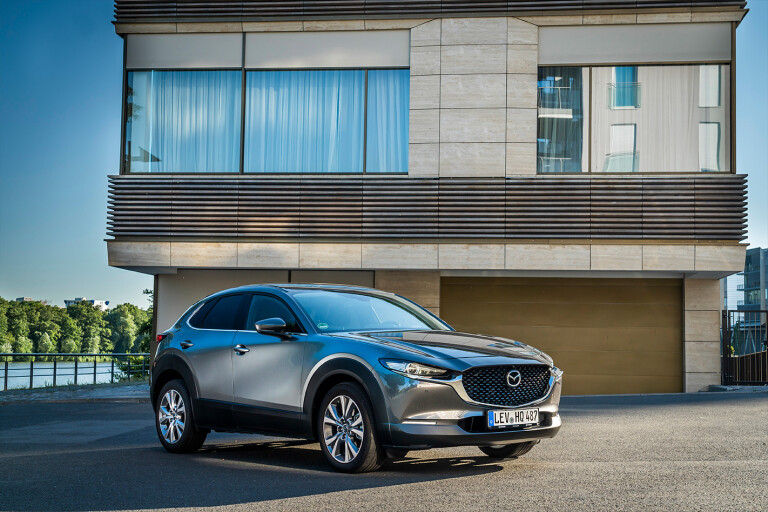
Clearly a lot of work has gone into the practical considerations of size. The wheelbase is actually 70mm shorter than the Mazda 3 hatch, but clever orientation of the fuel tank, allowing toe room under the front seats, canting the foot area to an advantageous angle, creating deep cutouts in the back of the front seats and making the rear seats more upright means that the rear feels more spacious. Its designers worked to ensure that 184cm adults could sit comfortably in the back. I’m a good deal taller than that and didn’t feel pinched in the rear.
It’s hard to fault the attention to detail in the design process. Take the luggage bay for instance. Mazda went into forensic detail regarding baby strollers, obtaining just about every possible design of stroller and figuring out how combinations of handle shapes, wheel sizes and just about every other stroller criterion you can imagine would fit into the 430-litre boot. Or the fact that the loading lip of the boot had to be less than 735mm high so that the average-sized woman could use straight arms to load the boot with heavy goods.

The exterior styling is, to this eye at least, a very respectable stab at the target of ‘sleek and bold’ that Mazda was aiming for. The black plastic cladding around the wheels and sills helps take visual bulk out of the car’s body, creating a sleek profile that features a distinctive S-shape of light and shade in the flank surfacing. Mazda has latterly become a market leader in the way it can create these subtle sheet metal lighting effects and the CX-30 moves the game on a step further. The angle of the C-pillar and rearmost side window gives it a coupe-like profile despite the actual roof maintaining its height for practical purposes.
On the road, it feels light and manoeuvrable, hardly surprising given that the turning circle is at 10.6m, the same as the minuscule Mazda CX3. The electrically-assisted steering is light but allows you to easily place the car. Ride quality was more than acceptable on some very smooth German roads, although we’d need to get the CX-30 on some seriously scabby Aussie bitumen before making any definitive pronouncements there. The test cars were riding on hefty 18-inch alloys and a smaller rim would probably pay dividends in terms of ride quality. I asked Yasuyoshi Mushitani, the CX-30’s vehicle dynamics guru, which tyre he preferred on the car and there was no hesitation. “It works best on 195/65/15 tyre,” was the response. Mazda’s marketing people died inside at that one.

Body roll is extremely well controlled, adding to that impression of agility. The automatic gearbox shifts cleanly but, like the CX-5, retains an annoying propensity to hold onto gears for too long. A subtle lift of the throttle pedal or a flick on the right-hand gearshift paddle rectifies this. That and a slight wind rustle around the door mirrors are about the only gripes you’d make respecting the overall refinement. Mazda has relocated the door speakers, realising that these represented a noise pathway and also sought to plug up any crevices in the chassis members where unwanted noise can creep into the cabin. As a result, it's easy to converse in the passenger cell, the couple distance – or space between the two front passengers – is, at 740mm, the same as the bigger CX-5. Should you not put too high a priority on quality conversation, an excellent optional 12-speaker Bose stereo is available.
All up it’s an extremely easy car to drive, helped by Mazda’s commitment to designing the cabin to help maintain your focus on the road. The infotainment system is mounted high on the dashtop, so you’re not perpetually adjusting your vision to look down at a touchscreen set against a dark fascia panel. That infotainment screen can be controlled by a tactile rotary controller and there’s now an excellent head-up display to further preclude the need to avert your gaze from the windscreen. The instrument binnacle houses a 7-inch screen and on the dashtop is an 8.8-inch TFT LCD display that features Apple CarPlay and Android Auto smartphone mirroring.
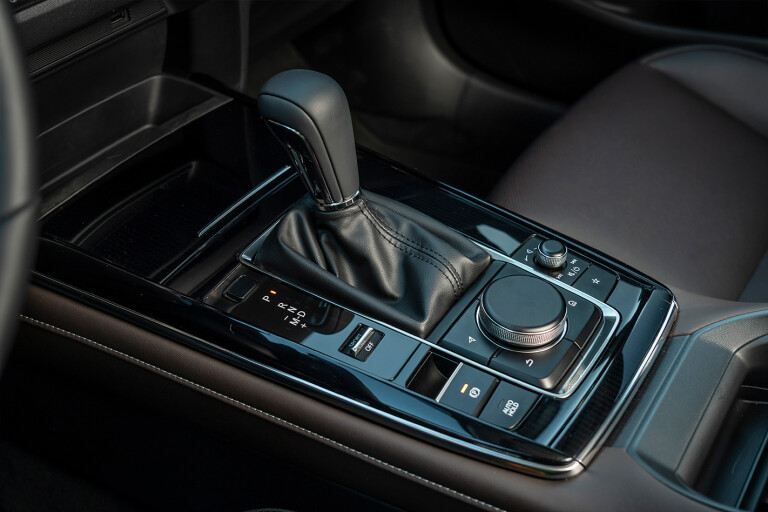
I wasn’t completely sold on the positioning of the door mirrors though. They’re big and set well back, and, as such, when you look into them it’s like suddenly watching an OLED television for the first time. The detail you pick up is amazing. What’s more there’s space to see ahead of the mirror, which means that when you’re negotiating something like a curving multi-storey down ramp, you can clearly see where the inside kerb is instead of having to guess. The downside of the mirror positioning is that it’s not so easy to just flick your eyes to it. Because it’s so far back, you’ll need to make a conscious turn of your head, the problem being exacerbated for shorter drivers who sit closer to the wheel.
Australia is set to get a choice of three engines. We drove the 90kW SkyActiv-G 2.0-litre petrol engine and the 85kW 1.8-litre Skyactiv-D diesel, the latter of which won’t be coming to these shores. The other two powerplants that look likely to appear are the fiendishly clever 132kW SkyActiv-X 2.0-litre compression-ignition petrol engine and the 140kW 2.5-litre normally-aspirated SkyActiv-G engine as seen in the CX-5. The 2.0-litre SkyActiv-G is a decent powerplant, its smoothness helped by a 24v mild hybrid system on the test car. This setup has not been confirmed for the Aussie market, so in the event that we don’t get the clever electricals, it’s likely that our power outputs will be boosted a little in recompense. Although these were pre-production versions not necessarily representative of what we’ll get next year, from our initial drive, I’d probably be tempted to hold out for the superior SkyActiv-X unit.
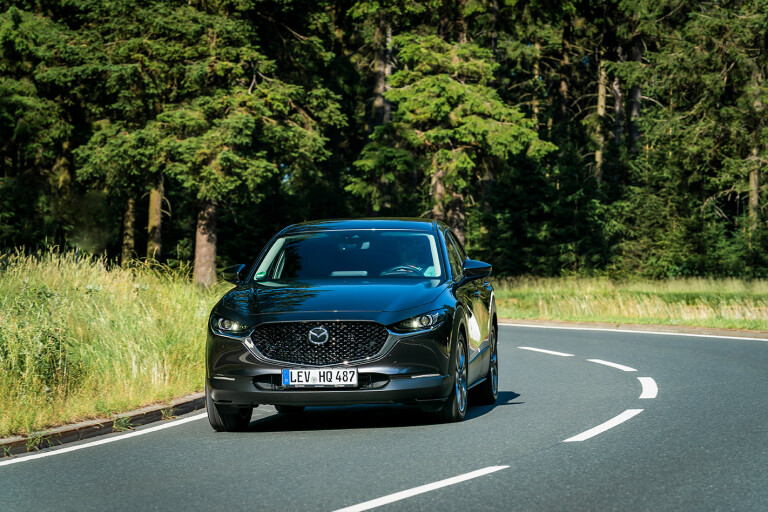
It’s also not certain whether manual transmissions will make the boat, but the six-speed automatic is a shoo-in. Both front- and all-wheel drive versions will be offered, so there will still be quite a broad selection of permutations available to Australian customers.
They’ll be rewarded with a vehicle that feels mature and extremely considered inside and out. Final equipment levels have yet to be inked in, but the fit and finish was excellent. The fascia design was particularly confident, Mazda resisting the urge that so many Japanese manufacturers succumb to of information overload. The dash is quietly styled and features some beautiful materials choices. The CX-30 genuinely does feel a class removed from cars like the Honda HR-V or Hyundai Kona.
The Mazda CX-30 is a quiet achiever. Its program manager Naohito Saga stressed the fact that he wanted it to be a desirable thing in its own right, not a distress purchase for families who might have grown out of a hatch. In that regard, it ought to be judged a success. There’s a vein of driver focus that runs throughout the car without overly compromising its practical considerations. Sometimes radical change is needed to move the game on and sometimes just doing the simple things well achieves the same end. The CX-30 doesn’t rewrite the rules. It merely understands them better than most.
MAZDA CX-30 VS RIVALS
Honda HR-V, Hyundai Kona, Mitsubishi Eclipse Cross, Peugeot 3008
MAZDA CX-30 PRICE AND SPECS (EUROPE-SPEC)
Model: Mazda CX-30 AWD
Engine: 1998cc 4-cyl dohc turbo petrol
Max power: 90kW @ 6000rpm
Max torque: 213Nm @ 4000rpm
Transmission: Six-speed automatic
0-100km/h: 9.5s [est]
Price: from $31,000[est]
On sale: Q1 2020




COMMENTS